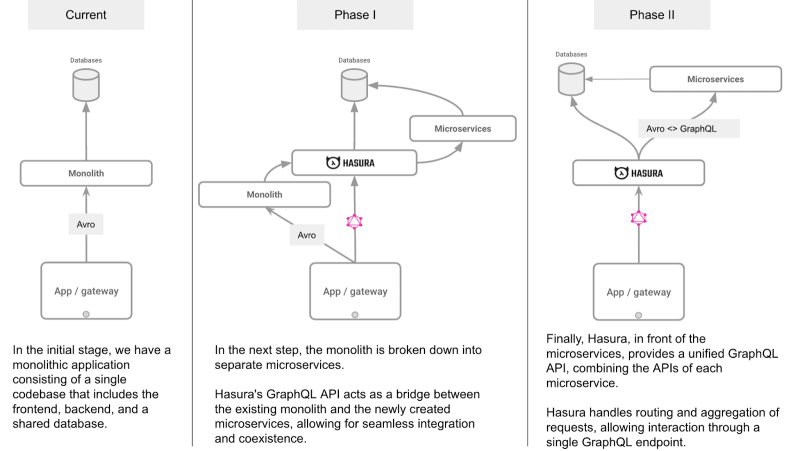Unleashing scalability and agility
As applications grow in size and complexity, the monolithic architecture that once served them well can become a bottleneck. Monolithic applications are difficult to scale, maintain, and deploy. Microservices, on the other hand, offer a more flexible and scalable architecture that allows for independent development and deployment of smaller, focused components.
In this blog post, we will explore how Hasura can help break up a monolithic application into microservices, enabling a more efficient and scalable architecture.
Understanding monoliths and microservices
Before diving into the migration process, it is important to understand the key differences between monolithic and microservices architectures.
In a monolithic architecture, the entire application is built as a single, tightly-coupled unit. This makes it difficult to isolate and scale individual components independently. On the other hand, microservices architecture breaks down the application into small, autonomous services that can be developed, deployed, and scaled independently.
Architecture
Let’s look at the detailed process of breaking a monolithic application into microservices step-by-step:
Step 1: Identify microservice boundaries
The first step in breaking up a monolith is to identify the boundaries of your microservices. This involves analyzing the existing monolithic application to identify cohesive and loosely coupled modules that can be decoupled and deployed as independent services. Each microservice should have its own bounded context and serve a specific business capability.
Step 2: Create GraphQL APIs with Hasura
Hasura provides a powerful GraphQL engine that can act as a gateway to your microservices. Instead of exposing each microservice's API directly to clients, you can create a unified GraphQL API using Hasura. Hasura simplifies this process by automatically generating the GraphQL schema based on the underlying data sources. You can leverage Hasura's console or configuration files to define relationships, access control rules, and custom business logic.
Step 3: Extract microservices from the monolith
With the microservice boundaries defined and the GraphQL API set up, you can start extracting individual microservices from the monolithic application. This can be done incrementally by identifying a well-defined module or functionality within the monolith and moving it into its own service. Hasura's GraphQL API acts as a bridge between the existing monolith and the newly created microservices, allowing for seamless integration and coexistence.
Step 4: Refactor and redesign
During the extraction process, you may need to refactor and redesign certain components to ensure they align with microservices principles. This may involve restructuring databases, revisiting domain models, and optimizing communication patterns between microservices. Hasura's powerful data modeling capabilities, such as handling relationships and custom resolvers, can assist in this process.
Step 5: Deployment and scalability
Once the microservices are extracted and properly designed, you can deploy them individually using your preferred deployment strategy. Hasura integrates well with popular containerization technologies like Docker and orchestration platforms like Kubernetes, making it easier to deploy and scale microservices. Each microservice can have its own independent deployment pipeline, enabling continuous delivery and reducing the risk associated with deploying changes.
Step 6: Monitor and maintain
Monitoring and maintaining microservices is crucial to ensure their health and performance. Hasura provides monitoring and logging capabilities that can be leveraged to gain insights into the usage, performance, and error handling of your microservices. By utilizing these tools, you can proactively identify and address any issues that may arise, ensuring the smooth operation of your distributed application.
Conclusion
Breaking up a monolithic application into microservices can be a complex undertaking, but with the help of Hasura, it becomes more manageable. Hasura's GraphQL engine simplifies the creation of a unified API layer for your microservices, enabling seamless integration and coexistence with the existing monolith.
By following the steps outlined in this blog post, you can transform your monolithic application into a scalable and flexible microservices architecture, unlocking the benefits of independent development, deployment, and scalability.




Top comments (0)